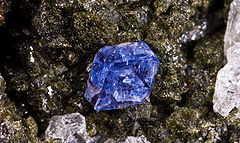Hauyne
| Haüyne | |
|---|---|

Haüyne on augite, Somma-Vesuvius Complex, Naples Province Italy
|
|
| General | |
| Category | Tectosilicate, sodalite group |
|
Formula (repeating unit) |
Na3Ca(Si3Al3)O12(SO4) |
| Strunz classification | 9.FB.10 (10 ed) 8/J.11-30 (8 ed) |
| Dana classification | 76.2.3.3 |
| Crystal system | Isometric |
| Crystal class | Hextetrahedral (43m) H-M symbol (4 3m) |
| Space group | P43n |
| Unit cell | a = 9.08 - 9.13 Å; Z = 2 |
| Identification | |
| Formula mass | 1,032.43 g/mol |
| Color | Blue, white, gray, yellow, green, pink |
| Crystal habit | Dodecahedral or pseudo-octahedral |
| Twinning | Common on {111} |
| Cleavage | Distinct on {110} |
| Fracture | Uneven to conchoidal |
| Tenacity | Brittle |
| Mohs scale hardness | 5 to 6 |
| Luster | Vitreous to greasy |
| Streak | Very pale blue to white |
| Diaphaneity | Transparent to translucent |
| Specific gravity | 2.4 to 2.5 |
| Optical properties | Isotropic |
| Refractive index | n = 1.494 to 1.509 |
| Birefringence | None, isotropic |
| Pleochroism | None, isotropic |
| Fusibility | 4.5 |
| Solubility | Gelatinises in acids |
| Other characteristics | May fluoresce orange to pink under longwave ultraviolet light |
| References | |
Hauyne, haüyne (pronunciation: /ɑːˈwin/), hauynite or haüynite is a tectosilicate mineral with sulfate, with endmember formula Na3Ca(Si3Al3)O12(SO4). As much as 5 wt % K2O may be present, and also H2O and Cl. It is a feldspathoid and a member of the sodalite group. Hauyne was first described in 1807 from samples discovered in Vesuvian lavas in Monte Somma, Italy, and was named in 1807 by Brunn-Neergard for the French crystallographer René Just Haüy (1743–1822). It is sometimes used as a gemstone.
Formulae:
All these minerals are feldspathoids. Haüyne forms a solid solution with nosean and with sodalite. Complete solid solution exists between synthetic nosean and haüyne at 600 °C, but only limited solid solution occurs in the sodalite-nosean and sodalite-haüyne systems.
Haüyne belongs to the hexatetrahedral class of the isometric system, 43m, space group P43n. It has one formula unit per unit cell (Z = 1), which is a cube with side length of 9 Å. More accurate measurements are as follows:
All silicates have a basic structural unit that is a tetrahedron with an oxygen ion O at each apex, and a silicon ion Si in the middle, forming (SiO4)4−. In tectosilicates (framework silicates) each oxygen ion is shared between two tetrahedra, linking all the tetrahedra together to form a framework. Since each O is shared between two tetrahedra only half of it "belongs" to the Si ion in either tetrahedron, and if no other components are present then the formula is SiO2, as in quartz.
...
Wikipedia
